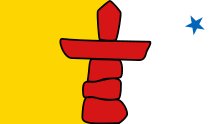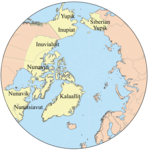Inuksuk

An inuksuk (plural inuksuit)
The inuksuk may historically have been used for navigation, as a point of reference, a marker for travel routes, fishing places, camps, hunting grounds, places of veneration, drift fences used in hunting,[4] or to mark a food cache.[5] The Iñupiat in northern Alaska used inuksuit to assist in the herding of caribou into contained areas for slaughter.[6] Varying in shape and size, the inuksuit have ancient roots in Inuit culture.[7]
Historically, the most common types of inuksuit are built with stone placed upon stone. The simplest type is a single stone positioned in an upright manner.[8] There is some debate as to whether the appearance of human- or cross-shaped cairns developed in the Inuit culture before the arrival of European missionaries and explorers.[citation needed] The size of some inuksuit suggests that the construction was often a communal effort.[4]
At Inuksuk Point (Enukso Point) on Baffin Island, there are more than 100 inuksuit. The site was designated a National Historic Site of Canada in 1969.[9][10]
Name

The word inuksuk means "that which acts in the capacity of a human".[11] The word comes from the morphemes inuk ("person")[12] and -suk ("ersatz, substitute"). It is pronounced inutsuk in Nunavik and the southern part of Baffin Island (see Inuit phonology for the linguistic reasons). In many of the central Nunavut dialects, it has the etymologically related name inuksugaq (plural: inuksugait).[citation needed]
While the predominant English spelling is inukshuk, both the Government of Nunavut
A structure similar to an inuksuk is called an inunnguaq (ᐃᓄᙳᐊᖅ, "imitation of a person", plural inunnguat); it is meant to represent a human figure. Inunnguaq has become widely familiar to non-Inuit, and is particularly found in Greenland.[15] However, it is not the most common type of inuksuk. It is distinguished from inuksuit in general.
The Hammer of Thor, located on the Ungava Peninsula, Quebec may be an inuksuk.[citation needed]
Modern usage

Inuksuit continue to serve as an Inuit cultural symbol. An inuksuk is the centrepiece of the flag and coat of arms of the Canadian territory of Nunavut, and the flag of Nunatsiavut. The Inuksuk High School in Iqaluit is named after the landmark.
Inuksuit—particularly, but not exclusively, of the inunnguaq variety—are also increasingly serving as a mainstream Canadian national symbol. In 1999, Inukshuk was the name for the International Arctic Art & Music Project of ARBOS in the Canadian provinces of Quebec, Ontario, Nunavik,[clarification needed] and Nunavut; and in Greenland, Austria, Denmark and Norway.[16]
On July 13, 2005, Canadian military personnel erected an inuksuk on Hans Island, along with a plaque and a Canadian flag, as part of Canada's longstanding dispute with Denmark over the small Arctic island.[17] The markers have been erected throughout the country, often as generic gateways into tourist regions, including a 9 m (30 ft) inuksuk that stands in Toronto on the shores of Lake Ontario. Located in Battery Park, it commemorates the World Youth Day 2002 festival that was held in the city in July 2002.
An inunnguaq is the basis of the logo of the

The Vancouver 2010 logo and the construction of inuksuit around the world have led to increasing recognition of them.[citation needed] There are five authentic inuksuit which were donated to other jurisdictions —wholly or in part—by the government of Canada: they are located in Brisbane, Australia;[20] Monterrey, Mexico; Oslo, Norway; Washington, D.C., United States; and Guatemala City, Guatemala.[21]

A Canadian-donated inuksuk was built in
The inuksuk was also used as the symbol of the Summit of the Americas, because of its connotations of "guidance and unity ... towards common goals."[22]
Officials in various wilderness parks throughout Canada routinely dismantle inuksuit constructed by hikers and campers, for fear that they could misdirect park visitors from the cairns and other markers that indicate hiking trails. The practice of erecting inuksuit in parks has become so widespread that Killarney Provincial Park, on the north shore of Ontario's Georgian Bay, issued a notice in 2007 urging visitors to "stop the invasion" of inuksuit.[23]
A large number of inuksuit have been built in some areas along the
In 2015, a small group of women near Hamilton, Ontario, constructed 1,181 inuksuit on the Chedoke Rail Trail to memorialize the issue of Missing and Murdered Indigenous Women, while seeking government action. It was one of many types of activism across the county, and the newly elected government committed to conducting a national inquiry that year.[25]
According to Guinness World Records, the tallest inuksuk is in Schomberg, Ontario, Canada. Built in 2007, it is 11.377 metres (37.33 ft) tall.[26]
On the occasion of the 20th Anniversary of the Rome Statute, to mark Canada's support for the International Criminal Court (ICC)[27] and as a symbol for its commitment to reconciliation with Canada's First Nations[citation needed], Canadian Minister of Justice and Attorney General Wilson-Raybould on 7 March 2018 donated an inuksuk as a gift to the ICC. It was unveiled by her and ICC President Judge Silvia Fernández de Gurmendi at the ICC premises in The Hague.[28]
In popular culture
The Canadian rock band Rush featured an inuksuk on the cover of their 1996 album Test for Echo.
Gallery
-
Inuksuk marking Canada's building site at Auroville, Tamil Nadu, India
-
This sculpture is situated in the western part of Toronto near Lake Ontario
-
Inuksuk in the vicinity of Kuujjuarapik, Quebec
-
Inuksuk gardens at Peggy's Cove, Nova Scotia, Canada
-
An inuksuk on the grounds of the National Assembly, Quebec City
-
Inuksuk on the shore ofsẁiẁs Provincial Park, Osoyoos Lake, British Columbia
-
Inuksuk sculpture byCanadian Embassy, Washington, D.C.
-
Very small Inuksuk in Drumheller, Alberta
-
Kandahar Inuksuk, June 2018
See also
- Badlands Guardian
- Cairn
- Dolmen
- Herma
- Monolith
- Missing and murdered Indigenous women
- Petroform
- Rock art
- Serge (religious)
- Totem pole
References
- ISBN 978-1-896204-29-1.
- ^ "Inukshuk". Asuilaak Living Dictionary. Retrieved 2007-02-16.[permanent dead link]
- ^ Ohokak, G.; M. Kadlun; B. Harnum. Inuinnaqtun–English Dictionary. Kitikmeot Heritage Society. Archived from the original on 2015-04-02. Retrieved 2014-12-27.
- ^ ISBN 978-0679312208.
- ^ "The Inuit Inukshuk". Simon Fraser University. Archived from the original on 23 December 2012. Retrieved 1 January 2013.
- ^ 28 Ethnobiology Conference Abstracts Archived 2008-05-30 at the Wayback Machine
- ^ The Inuit Inukshuk
- ^ Hallendy, Norman (8 December 2020). "Inuksuk (Inukshuk)". The Canadian Encyclopedia. Historica Canada.
- ^ "Inuksuk National Historic Site of Canada". Directory of Federal Heritage Designations, Parks Canada. Retrieved 22 July 2021.
- ^ Inuksuk National Historic Site of Canada. Canadian Register of Historic Places.
- ISBN 9781553654247.
- ^ "LivingDictionary.com - Online casino dictionary". www.livingdictionary.com. Retrieved 2020-11-29.
- ^ "Symbols of Nunavut". Government of Nunavut. Archived from the original on 2006-04-27. Retrieved 2006-06-13.
- Indigenous and Northern Affairs Canada. Archived from the originalon May 6, 2008. Retrieved 2006-06-13.
- S2CID 254605923.
- ISBN 3-85266-126-9
- ^ Press release from the Government of Canada, Foreign Affairs and International Trade. Google cache copy[permanent dead link].
- ^ "Vancouver Olympic emblem comes under fire". CBC News. 27 April 2005.
- NPR News. 18 February 2010.
- ^ "Australian Bicentenary | Monument Australia". monumentaustralia.org.au. Retrieved 2021-06-19.
- ^ Green, Sarah. "Inuit art finds home in Mexico", Toronto Sun, 2 Nov 2007, Retrieved 2007-11-08.
- ^ Proceedings of the XLVI Meeting of the Summit Implementation Review Group (SIRG)
- ^ Dubé, Rebecca (August 15, 2007). "Enough with the inukshuks already". The Globe and Mail. Toronto.
- Northern Life. September 22, 2010. Archivedfrom the original on October 30, 2015.
- ^ Adam Carter, "Aboriginal women remembered with 1,181 inukshuks" (sic- inuksuit), CBC News, 5 Nov 2015, posted at Remember Our Sisters website
- ^ "Tallest Inukshuk". Guinness World Records. Retrieved 1 January 2013.
- ^ "Canada and the International Criminal Court". Archived from the original on 2018-03-30. Retrieved 2018-03-30.
- ^ "Canada Justice Minister and ICC President unveil artwork donation". Archived from the original on 2020-11-16. Retrieved 2018-03-30.
Further reading
- "Vancouver Olympic emblem comes under fire". CBC News. April 26, 2005.
- Graburn, Nelson (2004). "Inuksuk: Icon of the Inuit of Nunavut". Études/Inuit/Studies. 28 (1): 69–82. S2CID 194117083.
- Heyes, Scott (2002). "Protecting the authenticity and integrity of inuksuit within the arctic milieu". Études/Inuit/Studies. 26 (2): 133–156. S2CID 190698081.
- Nunavut Tunngavik. pp. 18–19.
External links
- "Places of Power – essay and photographs of inuksuit". Canadian Museum of History.
- "Inukshuk". Heritage Minutes. Historica Canada. 1993.
- History of Inuksuk. .
- What is an Inukshuk?. Ap Verheggen. March 30, 2007. Archived from the original on 2021-12-21 – via YouTube.











